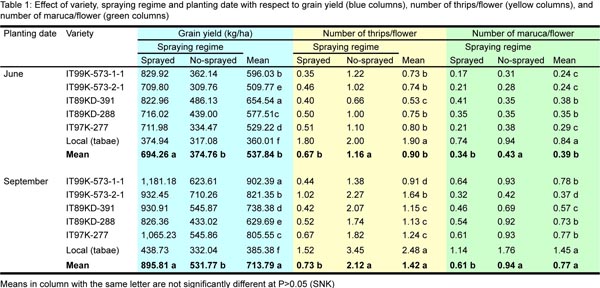|
Maruca caterpillar on cowpea |
Cowpea is the second most important grain legume in Sierra Leone after groundnut. The grain is valued for its nutritive content and short cooking time, and also favoured by farmers because of its ability to maintain soil fertility through its ability to fix nitrogen. Despite the high potential for production, yields have been generally low. Total yield losses and crop failure may occur due to several factors including the use of local varieties by farmers, time of planting, low soil fertility and insect pests. The most damaging of all insect pests are those that occur during the flowering and podding stages. Generally, the peasant farmers in Sierra Leone do not spray their crop with insecticide. Thus they rely on control through natural enemies. |
With support from N2Africa, trials were conducted in 2012 and 2013 to see how yields can be improved by reducing the population of both flowering and podding pests through integrated pest management options that combine the use of improved cowpea cultivars, planting date and well timed minimal insecticide application in three locations representing the forest and forest transition agro-ecologies.
Results from the study reveals significant differences (P˂0.05) in grain yield, haulm yield, biomass, number of nodules per plant, days to 50% flowering, days to 50% podding, days to maturity, pod load, number of thrips per flower and number of maruca per flower with respect to cultivar, date of planting and spraying regime. Grain yield was higher for the five improved varieties compared to the local variety across all locations, spraying regimes and time of planting with IT99K-573-1-1 recording the highest yield (Table 1). For the spraying regime, yields were one and half times higher in sprayed plots compared to unsprayed plots as spraying killed most of the yield limiting insect pests. In addition, higher yields with better grain quality were produced when planting was done in September compared with the June planting.

Thrips and maruca populations were generally low across spraying regimes and times of planting; however populations of these pest were higher in September compared to June with the un-sprayed plots recording significantly higher pest populations compared to the un-sprayed plots (Table 1).
In conclusion, cowpea yields can be improved in Sierra Leone by planting improved cultivars in September with spraying at flowering and podding stages.
Augustine Mansaray and Moses T. Moseray

